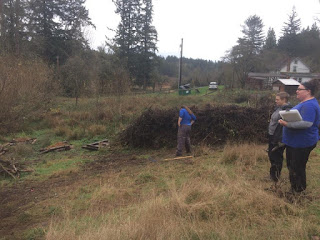The Edmonds Marsh is located in downtown Edmonds near the marina and the Edmonds Beach behind the Harbor Square recreational and workout center. The Marsh has a couple designated lookout areas in which you can watch the wildlife and observe without disturbing the wildlife and plant life too much. However, there is a dog daycare center literally two feet away from the plank in which the lookout points are located, and their insentient barking is a bit distracting.

This particular wetland would probably be considered a tidal marsh because of the plant life that is most prevalent in the area. Cattails are a very important part of the marsh ecosystem, and the perimeter of the Edmonds Marsh are completely covered with a dense amount of cattails and grasses. Also, marshes have undulating water circulating through them, and in this particular marsh, both salt and freshwater are constantly being replenished and and refreshed. I believe it would be considered a tidal marsh because of its close proximity to the Puget Sound.
Wetlands are very important for the environment. They control flooding, the absorb and hold pollutants that are headed for the ocean because of run off of pesticides and fertilizer, The replenish ground water, and they are a a very important habitat for resident birds, and a reprieve from migration for birds in migration. Wetlands also preserve biodiversity to the area by providing these services. Some of the organisms that I saw at this wetland were, cattails, snowberries, a variety of grasses, and many Great Blue Herron, The Cattails and the grasses provide shelter for smaller species of animals, such as mice and other rodents. Cattails are very dependent upon sunlight. They also provide an area for ground birds to hide and nest. The snowberries provide food for the grazers of the environment. Having a place for rodents to hide is important, because wetlands also have predatory birds such as hawks and owls, who need rodents as a food source.

The Narbeck Marsh was full of much bigger trees, such as Red Alder and Cedar trees. These provide shelter for birds of flight, such as the Pileated Woodpecker, a keystone species. In the Narbeck Marsh I also saw many more smaller birds such as the Black Capped Chickadee. The Chickadee's role is to spread seeds so that "Mother" trees do not have to compete with their offspring. The Narbeck marsh is not as salt-saturated as the Edmonds marsh, thus explaining the difference in vegetation. The bigger trees such as the cedar in the Narbeck marsh would not survive for long if they were only soaking up salt water.
Restoration of wetlands in Western Washington is very important because wetlands are so important for the ecosystem for the reasons that I described previously. In Western Washington in particular, wetland restoration is particularly important because we have allowed the Puget Sound to become so contaminated with pollution, that in certain areas, recreational fishing is not recommended, especially for shellfish. Restoration of marshes like the Edmonds Marsh are very important, because as an tidal marsh, it can prevent some of the pollution from reaching the Puget Sound.
I would guess that the type of restoration applied to the Edmonds Marsh would be the type that takes out invasive species and plants native ones. My reasoning is that I really didn't see any invasive species that I could identify, except for a few lone Himalayan Blackberry sprigs.
The most predominant tree in the marsh that I noticed was Red Alder of all ages on the perimeter of the marsh. Dead trees are important to the ecosystem in the wetlands because they are a great food source for birds. Insects love to live in dead trees (snags), and the birds are able to access the hollows of the snags with their sharp beaks. The woodpecker in particular is known for this, and the larger Pileated woodpecker can make holes so large in the snags that they can be used to house smaller birds.
I really didn't see any invasive species that I was able to identify. I saw some Himalayan Blackberry, but that was about it. Invasive species out compete the native species for resources. Because they are often not prone to the diseases of the area, they have no natural predators, and because they reproduce at high rates, they take over the niche of the native species. This decreases the biodiversity in the area by having one species basically snuff out another species.
My favorite part of seeing this wetland was when I first arrived. At first glance, the wetland appeared to be completely barren of life, although I know from class that this is not true, it certainly looked that way. Then, suddenly, I huge group of Blue Herrons arose from the pits of the marsh and flew above me in erratic circles. They had such large wing spans and were so beautiful that it opened my eyes to the beauty of the marsh.
I mentioned before that right next to the marsh is a dog daycare, I noticed that when I walked along the wooden planks the dogs would bark very loudly. The herons did not seem concerned. I then wondered if they had become so used to the dogs that they no longer perceive the dogs as a threat. I then wondered what kind of consequences this would have. Would their young not fear dogs? If a dog got loose in the marsh would they perceive its barking as a threat and be able to fly away in time? Anyway, very pretty marsh. Ill be going back here with my grandpa soon.







































